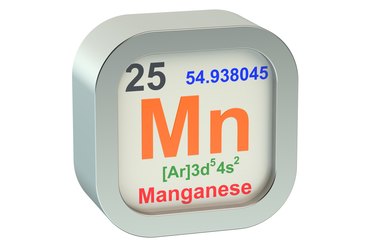
The reaction of potassium permanganate with sodium oxalate proceeds via a classic oxidation-reduction reaction. Two half-reactions make up the full reaction. In each half-reaction, chemicals either lose or gain electrons. In the end, the amount of electrons transfer balances, the number of atoms stays constant, but new chemicals, such as carbon dioxide, are formed.
Redox Reactions
Video of the Day
Oxidation-reduction reactions, or redox reactions, occur when electrons are transferred between substrates. The atom that gains electrons is said to be reduced and is the oxidizing agent. The atom that loses electrons is said to be oxidized and is the reducing agent. One device to remember this is "LEO goes GER", which stands for Losing Electrons is Oxidization and Gaining Electrons is Reduction. In the case of potassium permanganate and sodium oxalate, potassium permanganate is reduced while sodium oxalate is oxidized. More specifically, carbon from the oxalate anion loses electrons becoming oxidized while the manganese atom gains electrons and becomes reduced.
Video of the Day
Acid Requirement
In order for the reaction of sodium oxalate and potassium permanganate to occur, the solid sodium oxalate and potassium permanganate compounds must be dissolved in an acidic liquid to cause the dissociation of the reacting ions. For sodium oxalate or Na2C2O4, the oxalate or C2O4, must dissociate from two Na+ atoms and MnO4 must dissociate from potassium or the K+ atom. Typically, sulfuric acid is added to sodium oxalate to produce H2C2O4, or oxalic acid plus sodium chloride. The H2C2O4 oxalate in an acidic environment dissociates into C2O4 plus two H+ ions. Potassium permanganate in an acidic environment dissociates into the potassium or K+ ions and permanganate or MnO4- ions.
Oxidation Reaction
One half of a redox reaction occurs when an atom is oxidized, or loses electrons. In the case of potassium permanganate and sodium oxalate reaction, the oxidation occurs when the carbon atoms in oxalic acid lose electrons. In oxalic acid, the carbon atoms have a net charge of +3. At the end of the reaction, the carbon atoms become part of the carbon dioxide formed. In carbon dioxide, the carbon atoms have a net charge of +4. Although it appears as if carbon has gained a positive charge, in reality, they have just lost a single negative charge, making them more positive. Losing a single negative charge indicates they have lost an electron, or that they have been oxidized. In this half-reaction, 2 carbon atoms have each lost a single electron.
Reduction Reaction
A second half of a redox reaction occurs when an atom is reduced, or gains electrons. In the case of the reaction of sodium oxalate with potassium permanganate, manganese or Mn in the permanganate MnO4- ion, has a charge of +7. By the end of the reaction, the manganese has a charge of +2, existing as Mn+2 in solution. It has become less positive, changing from +7 to +2, by gaining electrons which carry a negative charge. In this half-reaction, 5 electrons are gained.
Balancing the Reaction
In order for a redox reaction to occur, the same number of electrons must be gained and lost, and no atoms can be created or destroyed. Because the reaction takes place in acid, many hydrogen or H+ ions are floating around, as well as water or H2O molecules. They can be added to either side of the equation in order to balance the number of hydrogen and oxygen atoms. While it appears that one half-reaction has lost two electrons, and another has gained five electrons, this is balanced by multiplying both sides of each half-reaction by a different number to yield the same number of electrons transferred for both reactions. For example, if you mulitply the oxidation reaction by 5 on both sides, a total of 10 electrons are transferred. If you multiple both sides of the reduction reaction by 2, a total of 10 electrons are transferred. When two sides of the equations are balanced and then combined into a single redox reaction equation, the result is 2 permanganate ions react with 5 oxalate ions in the presence of an acid to yield 10 carbon dioxide molecules, 2 manganese ions and water. In formula terms, this can be written as: 2 MnO4- + 5 H2C2O4 + 6 H+ =>10 CO2 + 2 Mn2+ + 8 H2O